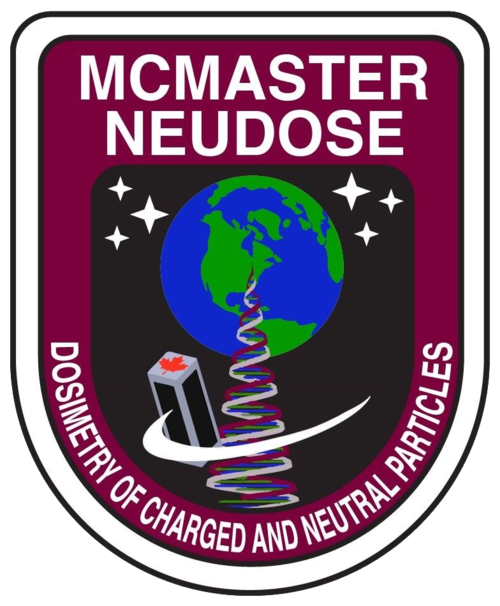Preparation for HASP 2018 has been underway the last few months, and with it we have been getting our Printed Circuit Boards (PCBs) manufactured. Here is a preview of our work on the ADS team's board. We will be populating the board with all the required parts in the following weeks. The board will use a combination of an accelerometer, gyroscope, and magnetometer to determine the attitude of the satellite (the orientation, rotation, and velocity).
NEUDOSE at Bruce Power
Luis, Diana, Eric, and Dr. Andrei Hanu attended Bruce Power's license renewal hearing by the Canadian Nuclear Safety Commission. Displaying our hard work and current mission progress, showing how Bruce Power gets involved in the community through their sponsorship of McMaster NEUDOSE. This public involvement helps to link us with the science community to ask us questions and provides a teachable opportunity.
Hira and Liubov place 1st in L3 WESCAM hackathon
Earlier this month, Hira Nadeem and Liubov Trofimova from the Command & Data Handling team participated and placed 1st in L3 WESCAM's first hackathon, HackWESCAM. In 36 hours, their team WeCycle used a trained neural network in a mobile app to scan and classify items to determine which recycling bin to place them in. An app like this would use geotagging to verify municipal recycling rules are being followed. Congratulations Hira and Liubov!
Featured on The Discovery Channel's Daily Planet!
At 3:23 in the video below is the Daily Planet feature of our team on the Discovery Channel! It is based on the CSA CubeSat program announcement from May 4.
We're going to space!
Today, the Canadian Space Agency has announced that as part of their Canadian CubeSat Program (CCP), the McMaster Interdisciplinary Satellite Team's NEUDOSE satellite will be launched from the International Space Station in 2021! A testament to the hard work and dedication of our team leaders and members, the NEUDOSE satellite will be launched and deployed from the ISS by the Canadarm after being (likely) delivered by a SpaceX Falcon 9 rocket.
We are extremely honoured and thankful to the CSA and our sponsors for providing this incredible opportunity. We will do our best to make to make Canada and our national space agency proud!
Check out this featured video by McMaster University!
Out of this world
Check out this latest rendering of the satellite structure, as designed by our mechanical team. The mechanical team's primary goal is to develop the structures that house all of the critical components of the satellite and radiation detector system. They also ensure the satellite is designed to the CubeSat dimensional and structural requirements for space flight. The mechanical structure will be tested as required by the team and launch provider.
The Design Process (with Altium Designer)
We are very thankful to our major sponsor Altium for providing us with Altium Designer software for designing Printed Circuit Boards (PCBs). Once our team designed the board, we had the board printed by the manufacturer based on the layout in the video. Once received, we assembled the board by applying solder paste, and heated it in a reflow oven.
This board in particular, designed by CDH team members Akiv and John, will be used in our HASP 2018 mission as the flight computer that handles data and monitors power in other systems. It was our first revision and many modifications were made from the errors discovered in the process.
Taking a look back at HASP 2017
As we make progress for the High Altitude Student Platform (HASP) 2018, we reflect to learn more about what we did right in the preparation for HASP 2017. As can be seen on the scuffs on our instrument shown, the landing process can be very damaging. Although it was not required to, our payload was able to survive the landing process. This instrument, the DINO (Dosimetric Instrument for Near-Earth Orbit) is what differentiates NEUDOSE from other CubeSat missions. To learn more, check out our about page.
Photo by Alex Melnichuk
Mechanical Design review
Yesterday on March 22, the Mechanical Team hosted their design review as we approach more rigorous preparation for High Altitude Student Platform (HASP) 2018. Mechanical team lead Ryan Scott shows off his team's hard work and 3D designs of the mechanical structure of the 2UDose satellite. These design reviews serve as a means of enhancing team communication and refining presentation skills.
Happy Pi Day!
On March 14 (3-14), we celebrate the date resembling the irrational number derived from the ratio of a circle's circumference to its diameter. One example of the uses of Pi is in calculations involving orbital geometries. These orbits are never perfectly circular, and contain slight or distinct elliptical resemblance. One of the factors to consider when determining an orbital path is ease of communication. Best communication will occur in an orbit that passes over our McMaster ground station. The potential orbit shown is one that maximizes sunlight for solar power generation.







